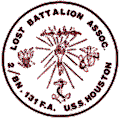|

|
|
|
|

|
The
Lost Battalion Association is composed of the men of the 2nd Battalion, 131st Field
Artillery and those men who swam ashore from the Cruiser USS Houston
(CA-30) when it was sunk, and who survived 42 months of "hell"
as prisoners of the Japanese during World War II.
|
|
|
|
The
2nd Battalion, along with the rest of the 36th Infantry
Division, was mobilized for federal service on November 20,
1940.
|
|
In
the photograph at the right are some of the young men of Headquarters Company,
2nd Battalion, 131st Field Artillery. Photograph was taken
during late 1939. Kyle Thompson, author of A Thousand Cups of
Rice: Surviving the Death Railway, stands in the second row
at the far right. View
WWII strength and casualty statisics |
|
|
| |
|
|
|
On
Thursday, December 18, 1941, the 36th Infantry Division commander, Major
General Fred L. Walker, wrote in his journal:
"Last
month we shipped off the 2nd Battalion of the 131st Field Artillery to
the Philippines. Persons who have received letters from friends in that
battalion tell me that it sailed from Hawaii on about November 28th. If
this is correct, their transport may have been in the vicinity of Guam
or west thereof on December 7th. It is my belief, however, that they
have evaded the Japanese sea attacks and are now either at their
destination or at some other port in the Pacific. We are all quite
concerned about them."
|
| |
|
|
WWII
HISTORY
OF THE 2nd BATTALION,
131st FIELD ARTILLERY
"The
theater on the middle parade grounds in the Allied POW camp at Tamarkan,
which was near the north bank of the Kwae Noi River. Note the prisoner
on stage dressed only in a g-string cloth, common apparel after nearly
three years as prisoners of the Japanese Army. - AWM negative
#157871"
|
|
|
|
|
|
|
"On January 11, 1942, 35 days after the outbreak of War with Japan, the Battalion was on Java, the only U. S. ground combat Unit to reach the Netherland East Indies, before the Dutch capitulated to the Japanese."
"January
21, 1943, found us again packing our meager possessions and marching out
of the Moulmein prison. We walked through the town, which still appeared
deserted, to the nearby railway station. There we boarded more small,
hot, Asian boxcars for a thirty-mile journey to the town of Thanbyuzayat,
the staging area for the northern end of the Death Railway." - Kyle
Thompson
Click
on map for a larger view.
|
|
|
|
|
A
typical prisoner of war camp in Burma and Thailand on the Death
Railway. This picture is of a camp in the Burma jungles and
shows Allied POWS in various states of "jungle dress"
outside their bamboo and grass barracks. -AWM negative
#157870" |
|
|
| |
|
|
|
| |
|

|